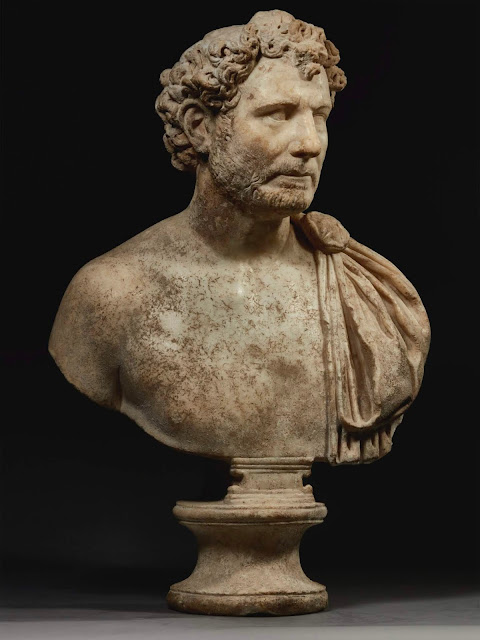Getty Buys a Great Roman, Formerly of Denver
The Getty Museum has acquired a Roman Portrait Bust of a Man, AD 140-160. Formerly owned by the Denver Art Museum (DAM), it was deaccessioned through Sotheby's London in 2017. There it sold for £728,750 (about $1 million).
It's unusual for an encyclopedic museum to sell a major antiquity, something increasingly hard to buy at any price. The sale proceeds went to buy other art for Denver. The DAM does not have an antiquities department and has in recent years focused on Spanish Colonial and Western American art.
Roman naturalism reached its peak during the 2nd-century Antonine dynasty. The Portrait Bust of a Man is nearly contemporary with a well-preserved female portrait of similar format in the Getty Villa collection. It's a generation or two earlier than the Getty's AD 180-185 Bust of Emperor Commodus, last of the Antonines (above right). Such works were influential in the Renaissance. Antico's bronze Bust of a Young Man, at the Getty Center, is based on an Antonine marble.
Like Commodus, the new bust's unknown sitter wears a military cape with brooch. That probably means he was an aristocrat who did a short term of duty, maybe to further a political career. Sotheby's said the tips of the nose and beard are restored. The round socle is the ancient original; counting it, the bust is 30 inches high.
Portrait Bust of a Man, set to go on view in July, is one of several antiquities lately acquired for the reinstalled Villa, including an Etruscan bronze and a Roman theatrical relief.
It's unusual for an encyclopedic museum to sell a major antiquity, something increasingly hard to buy at any price. The sale proceeds went to buy other art for Denver. The DAM does not have an antiquities department and has in recent years focused on Spanish Colonial and Western American art.
Roman naturalism reached its peak during the 2nd-century Antonine dynasty. The Portrait Bust of a Man is nearly contemporary with a well-preserved female portrait of similar format in the Getty Villa collection. It's a generation or two earlier than the Getty's AD 180-185 Bust of Emperor Commodus, last of the Antonines (above right). Such works were influential in the Renaissance. Antico's bronze Bust of a Young Man, at the Getty Center, is based on an Antonine marble.
Like Commodus, the new bust's unknown sitter wears a military cape with brooch. That probably means he was an aristocrat who did a short term of duty, maybe to further a political career. Sotheby's said the tips of the nose and beard are restored. The round socle is the ancient original; counting it, the bust is 30 inches high.
Portrait Bust of a Man, set to go on view in July, is one of several antiquities lately acquired for the reinstalled Villa, including an Etruscan bronze and a Roman theatrical relief.



Comments
By contrast, the bust of Emperor Commodus looks more typical of sculpted faces from the distant past.